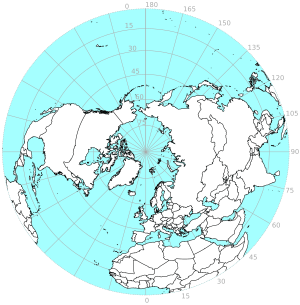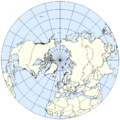Northern hemisphere facts for kids
The Northern Hemisphere is the half of Earth that is north of the equator. Imagine a giant invisible line around the middle of our planet – that's the equator! Everything above it is the Northern Hemisphere.
This part of the world is home to about 90 percent of the global population and most of the world's land. All of North America and Europe are found here. Most of Asia, about two-thirds of Africa, and a small part (10 percent) of South America are also in this hemisphere. The three largest countries by population – China, India, and the United States – are all in the Northern Hemisphere.

Contents
What is the Northern Hemisphere?
The Northern Hemisphere is one of the two main halves of Earth, separated by the equator. It includes the North Pole at its very center. When it's summer in the Northern Hemisphere, it's winter in the Southern Hemisphere, and vice versa. This happens because of how Earth tilts on its axis as it orbits the Sun.
Land and People
Most of Earth's landmass is located in the Northern Hemisphere. This includes huge continents like North America, Europe, and most of Asia. Because there's so much land, there are also many different climates and environments. From the icy Arctic Circle to warm tropical regions near the equator, the Northern Hemisphere has a huge variety of landscapes.
With so much land, it's no surprise that most of the world's people live here. Many of the world's largest cities and most populated countries are in the Northern Hemisphere. This means there's a rich mix of cultures, languages, and traditions.
Climate and Seasons
The Northern Hemisphere experiences all four Seasons: spring, summer, autumn (fall), and winter. The seasons are opposite to those in the Southern Hemisphere. For example, when it's summer in July and August in places like the United States or Europe, it's winter in countries like Australia or Argentina in the Southern Hemisphere.
The longest day of the year in the Northern Hemisphere is around June 21, known as the summer solstice. This is when the Sun is directly over the Tropic of Cancer. The shortest day is around December 21, called the winter solstice, when the Sun is directly over the Tropic of Capricorn in the Southern Hemisphere. The equinoxes, around March 20 and September 22, are when day and night are roughly equal in length.
Interesting Facts
- The Northern Hemisphere has a larger proportion of land compared to the Southern Hemisphere.
- Most of the world's major mountain ranges, like the Himalayas and the Rocky Mountains, are in the Northern Hemisphere.
- The Arctic Ocean, which is mostly covered in ice, is located entirely within the Northern Hemisphere.
- During the last ice ages, huge ice sheets covered much of the Northern Hemisphere, especially North America and Europe.
See also
- Southern Hemisphere
- Eastern hemisphere
- Western hemisphere
- Seasons
- Solstice and equinox
- Equator
- Tropic of Cancer
- Tropic of Capricorn
- Arctic Circle
- Antarctic Circle
 In Spanish: Hemisferio norte para niños
In Spanish: Hemisferio norte para niños
Images for kids
-
Northern Hemisphere from above the North Pole
-
Northern hemisphere glaciation during the last ice ages. The setup of 3 to 4 kilometer thick ice sheets caused a sea level lowering of about 120 m.
-
Canadian Rockies in North America




